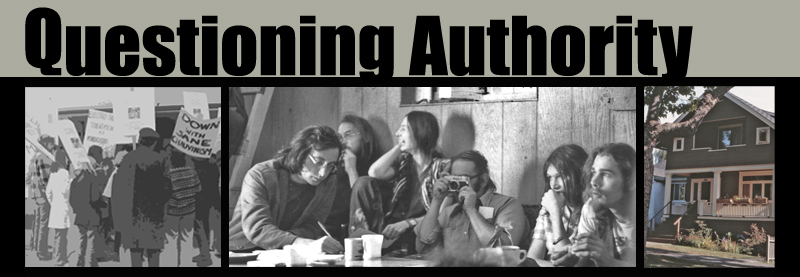More for the Mind: Home > Questioning Authority Home
Lesson 2: The MPA – A Case Study
Approximately three one hour classes
Day One
 Opener: “Lanny and the MPA” (20 minutes)
Opener: “Lanny and the MPA” (20 minutes)
- Review the previous day’s material and tell students today they’ll be looking at a specific group, the Mental Patients’ Association (MPA)
- Discuss the name and the importance of reclaiming labels
- Introduce the video, which is based on an interview with one of the organizers of the MPA
- After the video, discuss key information: what needs led to the formation of the MPA, what services did the MPA offer to its members
 Activity: Research (minimally 30 – 40 minutes)
Activity: Research (minimally 30 – 40 minutes)
- Direct students to resources about the MPA (see below)
- Ask students to take notes about the beginnings, the organization and the goals of the MPA
- Ideally, if time allows, students would spend a second day of research and class sharing
 Closing: MPA (5-10 minutes)
Closing: MPA (5-10 minutes)
- Use chart paper to record student comments and create a summary about the MPA, using the categories above
Day Two
 Opener: In a Nutshell Funding Cartoon (5 minutes)
Opener: In a Nutshell Funding Cartoon (5 minutes)
- Show learners the funding cartoon from In a Nutshell
- Ask students to decipher what the cartoon is depicting
- Point out that while the cartoon is overstating how many things were funded by the Vancouver Resource Board, organizations such as the MPA were heavily reliant on grants for funding
 Activity: Sell a proposal (50-55 minutes)
Activity: Sell a proposal (50-55 minutes)
- Using a fictional LIP grant form, students work in groups of 2 to 4 to put together an oral proposal to request funding for some aspect of the MPA, for example money to open a group home, a collective farm, a business to provide jobs for ex-patients
- The applications should use information from the student’s research
- Learners will be asked to make a formal oral presentation requesting money and field questions from a ‘panel adjudicator’ (the teacher). Presentations should be three to six minutes in length
Day Three
 Activity: Presentations (50-55 minutes)
Activity: Presentations (50-55 minutes)
- Students present to teacher and other learners
- Teacher acts as an adjudicator and asks questions before decided to grant the group the full amount or offering partial funding
 Closing: Review (5-10 minutes)
Closing: Review (5-10 minutes)
- Review the founding, the organization and the gains of the MPA
 Reaching All Learners
Reaching All Learners
-
Struggling readers may be supported in several ways. Some ways include:
-
pairing them with another student
-
providing the information ahead of time to allow practice and more time to read
-
by the teacher choosing shorter, more accessible articles for them to use for research
-
- Most students will feel comfortable presenting in a group in an informal classroom presentation, but for those who are extremely anxious, provide options, such as:
- presenting to the teacher while the other groups are practicing or after school
- note taking on the other presentations
- a written summary
- Although these activities do not include much writing, some students might benefit from the use of a scribe or technological writing tool such as Kurzweil
- Students who struggle with organization or those in younger grades might benefit from structure for their note taking. For example, specific questions to answer or a fill-in-the blanks note taking sheet
 Extension Activities
Extension Activities
- Take part in a protest:
- After reviewing the resources dealing with the 1973 Riverview Protest, ask students to reenact or create a skit or speech in the style of the Riverview Protest
- Students could also make protest signs based on the Bob Hunter article
- Participatory Democracy
- Discuss as a group the democratic principles underlying the MPA’s organization. For example, decision making as a group, rather than by a representative leader
- What are the advantages and disadvantages of this model?
- This activity can be extended by dividing the class into groups. Each group would be given a card describing the type of government they should use (dictatorship, representative democracy, participatory democracy –more if you wish) and then each group would be given the same problem to address. Debriefing as a whole class could discuss quality of the decisions, efficiency of the decision making process, feelings of inclusion and empowerment or disenfranchisement
 Resources
Resources
Day One: Opener
Day One: Activity
- MPA poem, In a Nutshell, vol 3, no 7, 1975
- MPA in a Nutshell, In a Nutshell, vol 4, no 1, 1976
- MPA Information Leaflet
- MPA public meeting July 24 1973
- A Week in the Life With MPA
- Evaluation of the MPA as an Opportunities Placement
- Dear MPA Member
- MPA pamphlet Rock Opera Act II
- Bob Hunter column, Vancouver Sun, August 12, 1971, p.37
- “Self-help down on the FUNNI farm,” Vancouver Sun, February 12, 1972, p.11
- “Effects of shock treatment studied,” Vancouver Sun, January 12, 1976, p.5
- “Ex-mental patients take off their masks,” Vancouver Sun, November 13, 1974, p.24
- “Self-help is target of mental patients,” Vancouver Sun, July 24, 1978, p. A15i
- “Mental patient fear loss of autonomy,” Vancouver Sun, June 24, 1976, p.37
Day Two: Opener
- In a Nutshell, Funding Cartoon
Day Two: Activity
Day Three: Extension Activities
